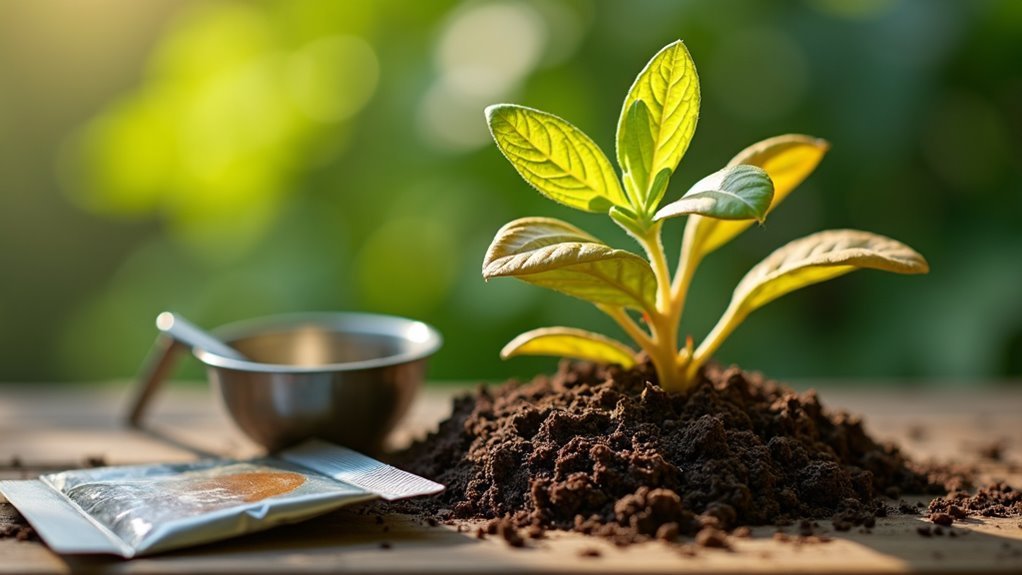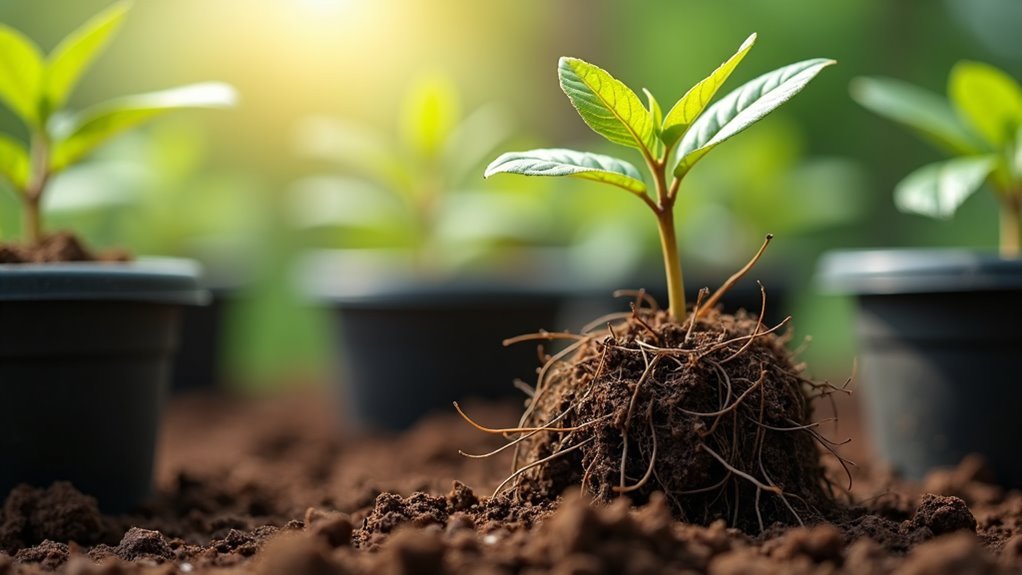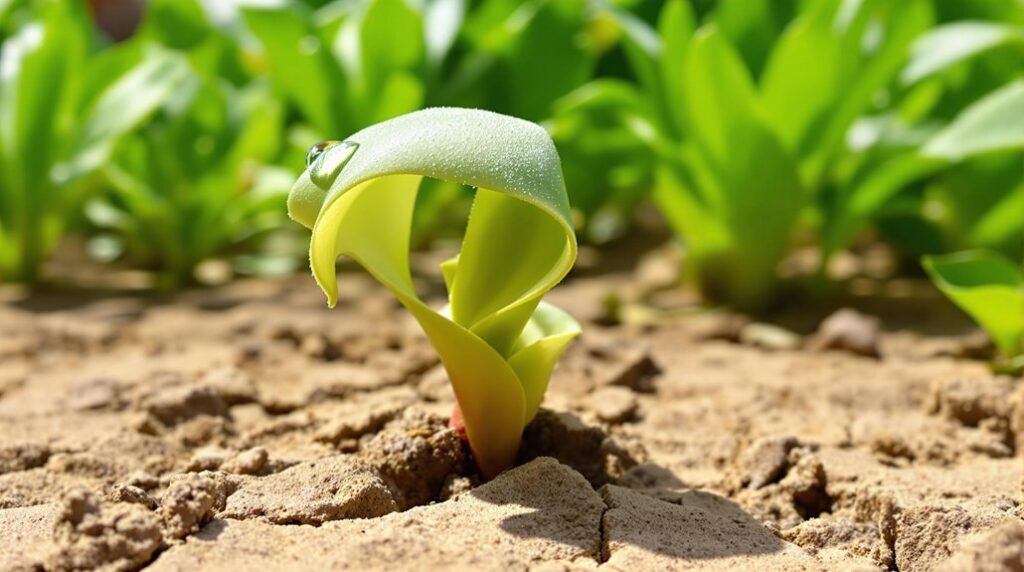If your plants aren’t growing as they should, it’s time to pinpoint what’s holding them back. You might be dealing with issues like too little light, improper watering, or nutrient shortages—each one affecting growth in subtle but significant ways. Before you reach for another fertilizer or move your plants again, understanding the root cause is essential. Let’s explore common pitfalls that could be stunting your plants and how to address them effectively.
Lack of Light
If your plant isn’t getting enough light, its growth will slow, and you might notice pale or yellowing leaves. This lack of light directly impacts photosynthesis, causing stunted growth.
Different plants have varying light needs—some thrive in direct sunlight, while others prefer indirect light. You need to understand your plant’s specific requirements to avoid problems.
Proper positioning plays a big role: place high-light plants in bright spots and low-light plants where they get filtered light.
When natural light is insufficient, supplement with grow lights, adjusting their distance regularly to provide ideal exposure.
Monitoring and adapting to your plant’s light needs prevents weak, leggy growth and keeps your plant healthy and vibrant despite indoor lighting challenges.
Overwatering and Underwatering
When you water your plant too much or too little, its growth can quickly suffer. Overwatering drowns roots, causing yellow leaves and root rot, while underwatering leads to wilting and stunted growth as plants conserve water. To check moisture, stick your finger an inch into the soil—dry means it’s time to water; soggy means overwatering. Use the Lift-the-Pot method: a light pot needs water, a heavy one indicates excess moisture. Remember, each plant has unique watering needs, so adjust your schedule to allow a wet/dry cycle for healthy roots.
| Condition | Signs |
|---|---|
| Overwatering | Yellow leaves, soggy soil |
| Underwatering | Wilting, dry soil |
| Check Method 1 | Finger test (1 inch deep) |
| Check Method 2 | Lift-the-Pot weight |
Nutrient Deficiency

Although plants need water and light to thrive, they also require critical nutrients like nitrogen, phosphorus, and potassium to grow properly.
If your plant shows stunted growth, yellowing leaves, or poor flowering, it may lack these fundamental nutrients. Nitrogen deficiency often causes pale green or yellow leaves since it’s important for chlorophyll production.
Phosphorus shortage can stunt root development and delay flowering, weakening your plant’s overall vigor. To tackle this, test your soil regularly to pinpoint deficiencies.
Then, apply a well-balanced, slow-release fertilizer to replenish vital nutrients without risking overload. For example, slow-release fertilizers like Osmocote provide steady feeding and help promote consistent growth. By addressing nutrient deficiencies promptly, you’ll help your plant regain health and prevent stunted growth, ensuring it grows strong and thrives.
Improper Drainage
Because poor drainage traps water around the roots, your plant can’t get the oxygen it needs, which stunts its growth. Improper drainage leads to waterlogged soil that causes root rot, damaging your plant’s root system. To prevent this, use well-draining soil and pots with drainage holes. Monitor soil moisture regularly and adjust watering to maintain a healthy wet/dry cycle.
| Issue | Cause | Solution |
|---|---|---|
| Waterlogging | Improper drainage | Use well-draining soil, add compost |
| Root rot | Excess moisture | guarantee drainage holes, reduce watering |
| Stunted growth | Lack of oxygen | Improve soil aeration |
| Dry soil | Underwatering | Adjust watering frequency |
Root Confinement

If your plant shows stunted growth or yellowing leaves despite proper care, root confinement might be the cause.
Root confinement happens when roots become tangled or compressed inside the pot, restricting their access to water and nutrients. This leads to poor nutrient uptake and stunted plant growth.
To fix this, repot your plant into a container 1-2 inches larger in diameter with fresh, nutrient-rich soil. Gently untangle the roots to minimize transplant shock and give them room to spread.
Regularly check root health and repot as needed to prevent root confinement from recurring. Addressing this issue promptly guarantees your plant regains vigor and continues growing healthily without the setbacks caused by cramped roots.
Temperature Stress
When temperatures soar too high or dip too low, your plant’s metabolic processes can quickly get disrupted, leading to stunted growth and other visible signs of stress.
Temperature stress causes wilting, leaf drop, and poor flowering, all of which hinder healthy growth. To prevent this, keep your plants within an ideal range—typically 65°F to 75°F (18°C to 24°C).
Sudden temperature changes can shock your plants, so try to shield them from drafts and heating or cooling appliances that cause fluctuations. Regularly monitoring local weather and adjusting indoor conditions accordingly can help you maintain a stable environment.
Pests and Incorrect Ph Levels 🌱📈
Although pests like aphids, spider mites, and mealybugs might seem small, they can quickly sap your plant’s nutrients and stunt its growth.
Pests drain energy, while incorrect PH LEVELS reduce nutrient uptake, causing deficiencies and poor development. To keep your plants healthy, focus on both pest control and soil pH management.
Pests sap energy and wrong pH blocks nutrients; balance both for healthy, thriving plants.
- Inspect plants regularly for signs of pests such as distorted leaves or webbing
- Use organic treatments like neem oil or insecticidal soap to manage infestations
- Test soil PH LEVELS periodically, aiming for an ideal range of 5.8 to 6.4
- Adjust PH with lime (to raise) or sulfur (to lower) to guarantee nutrient availability
Frequently Asked Questions
How Do You Fix Stunted Plant Growth?
You fix stunted plant growth by adjusting watering to avoid overwatering, improving soil with compost, ensuring proper temperature, testing soil pH, applying balanced fertilizer, and treating pests or diseases promptly to encourage healthy development.
What Causes Stunted Growth in Plants?
You’ll find stunted growth caused by drought, sustained winds, waterlogged soil, poor transplant quality, or extreme temperature swings. These conditions stress your plants, damaging roots or disrupting metabolism, which slows their development and vigor.
Can You Fix Stunted Growth?
Yes, you can fix stunted growth by adjusting light, watering properly, improving soil nutrients, ensuring good drainage, and managing temperature and humidity. Regular care and monitoring help your plants recover and thrive.
What Does Stunted Growth Look Like in Plants?
Oh, you’ll definitely notice your plant’s “fun-sized” stature—short, droopy leaves clawing for attention, pale or yellow hues, and weak roots. It’s like your plant’s decided to skip leg day forever, struggling to thrive.
Final Thoughts
Think of your plant like a car—without the right fuel, light, and care, it won’t run smoothly. Just like Sarah once struggled with her wilting fern until she adjusted its light and watering, you can bring your plants back to life by addressing key issues like light, water, and nutrients. Keep an eye on these factors, and your plants will thrive, turning your space into a vibrant, green oasis rather than a stunted patch.
